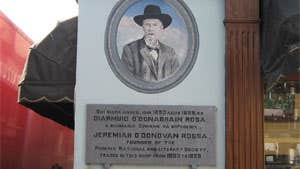Some sites commemorate great works of philanthropy, others of emigration, more of Relief Schemes, while others tell of famine, fever and death. The Trail offers an overview of conditions in the area during the period 1840-50.
Aftermath
One immediate consequence of the Great Famine was the death of a whole generation. In the town, whole lanes, like Coppinger's, Table and Clerke's lay deserted, while there were numerous unoccupied houses in Bridgetown, High Street and Chapel Lane.
Emigration was now common. Workhouses were more feared than ever. There was hatred. Many farm holdings had disappeared. The potato began to lose its dominant role in the Irish diet, while cattle and dairying began to increase.
The spirit of Republicanism which had been kindled in 1798 might have flickered in the 1830's and 40's, but it sprang to life again in the late 1850's, when Phoenix Society began to make preparations for a revolution. The flames were no longer confined to Ireland, but were now fuelled by the Famine emigrants who had settled in the U.S., Canada and England. The line ... "And loud and high we'll raise the cry, Revenge for Skibbereen." was eventually to become a reality.
